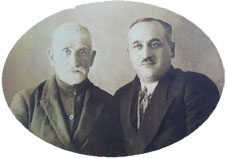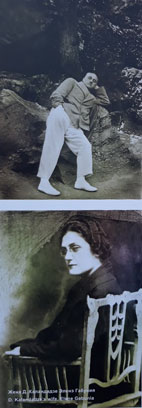
David Kalandadze - Country of Liquid Sun
Wednesday, May 20
Kalandadze is ancient Georgian family name, The main branch of this family lived in the village of Khidistavi in the Chokhatauri district from which they migrated to neightiouring villages and their dwelling places named after them: Kalandadze district in Erketi and Ianeuli, Kalandadze river-side forest in Tolebi, Kalandadze place in Intabueti and Jvartsma (presently Chaisubani). Kaiandiadze pasture in Kvabgha, Kalandadze graveyard in Tavpanta and Sakvavistke (presently Dablatsikhe) and Kalandadze spring in Bukistsikhe, amongst others.
David Kalandadze was born in 1889 in the village of Khidistavi Chokhotauri district, Ozurgeti region, Kutaisi Province. Khidistavi, which is located on the Chokhataurl-Bakhmaro road, is distinguished by its geographic location and remarkable population.
After finishing the Khidistavi primary school, David Kalandadze continued his studies at the Kutaisi Gymnasium, David's father, who was a well-to do man, was anxious to provide his children with a good education. After finishing the gymnasium, David Kalandadze left for Kharkiv where he was enrolled in the Pharmaceutical Department of the city's University and studied chemistry and the technology of food products as well as the French and Latin languages. After graduating from the University, he undertook practical activities in Kharkiv and worked at various private pharmacies in the city for certain period of time. In 1915, at the age of 26, he returned to his homeland.
David Kalandadze's return to Georgia coincided with the beginning of the First World War. The boundless Russian Empire was involved in the War and, on the order of Nicholas II, men were called to the army on a mass scale. The War made life stricter and also held it back. Educated people were required to work in various positions. Kalandadze worked as chemist and pharmacist for several years at various places, having acquired extensive practice, and accumulated a rather large personal capital. He was the shareholder and member of Supervisory Board of Jacob Zemel's pharmacy, well-known in Tbilisi, as well as the Factory of Champagne and Mineral Waters. David also had close relations with the Sarajishvili Factory, located on Olga Street in Tbilisi, which, after the death of the great manufacturer and Maecenas was directed by his wife, Ekaterine Porakishvili, from 1911. Kalandadze had business contacts with companies producing spirits, vodka, cognac, liqueur and other alcoholic beverages. Amongst them was the Sesiashvili Brothers firm, established in 1890, whose main factory was located on 6 Sadguri Street in Tbilisi and with a branch office in Batumi where Kalandadze made friends with the brothers. Mikheil and Dimitri Sesiashvili, and later became their relative with his marriage to Dimitri's daughter. This marriage proved to be short-term although it did not interfere with business relations with the Sesiashvilis and their firm.
In 1920, Mikhell Sesiashvili, David Kalandadze, Alexander Jakeli and Ivan Fokas concluded agreement with each other in Batumi and provided assistance to Prince Oldenburgsky, who did many good things in Georgia, for the making of cognac and champagne wines. Tiebo exhausted by disease, ultimately had to sell his marvelous Klo-Uguruli. From 1926, Kalandadze worked basically in Tbilisi and managed a small capacity spirit, wine and vinegar factory located near the Mukhran Bridge (presently, the Baratashvili Bridge). This period was extremely difficult for Georgian people with a change in the system of government which was followed by repressions in 1937 and then the difficult years preceding the Second World War.
The Second World War started in 1942 and the country was in a military regime. Kalandadze did not stop his activities but supplied spirits to military hospitals and clinics and vinegar to food facilities. He was one of the first who began to produce wine vinegar based upon industrial processing. Before then, vinegar was home-made with the use of sour wine. Vinegar is a complex biological product and has specific technological peculiarities - the production of vinegar of a nutritional value from high-quality wine by complex biological implies the use of spirits and vinegar ferment. Kalandadze, who excellently processes coped with the new initiative, was the director of the first factory producing natural vinegar industrially. During this period, a Gurian man from Khidistavi by the same surname of Kalandadze and who held an ordinary position at the factory was found guilty of smuggling spirits from the territory of the factory, and punished according to the law. He was detained by the law enforcement officers whilst trying to leave the territory and arrested. The arrested Kalandadze mentioned David Kalandadze as a co-actor of confirmed his participation in the crime.
David Kalandadze spent a year in jail before the truth was revealed. His factory and family members were searched and his money, jewelry and other possessions were seized-and illegally so-as well as his movable and immovable property and his bank accounts were frozen. Kalandadze was found to be innocent but the experience impacted very negatively upon his health and well-being and resulted in a worsening of his diabetes.
After being cleared of the charges, Kalandadze, as famous pharmacist, was suggested, upon the request of the leaders of the Central Pharmaceutical Department, to put an oxygen factory into operation in Tbilisi. Oxygen production in Georgia was dispersed in the form of small, primitive and hardly functioning workshops with oxygen in a permanent deficit despite the high demand.
Kalandadze began to set up the oxygen factory in 1949. It required a highly efficient staff, the selection of a proper workforce, the acquisition of equipment and the setting up of workshops. For the purpose of mastering the task, he went to Russia and after obtaining a certain knowledge on the topic, he began to produce oxygen. Most importantly, the issue of supplying the factory with oxygen cylinders was settled which was a difficult problem to solve at that time. The only technologically sound oxygen factory in the Republic was located in Navtlughi, and the produced oxygen, in addition to medical purposes, was used in the building industry.
David Kalkandadze worked in that position until 1955. He died at the age of 66 owing to complications from diabetes. He was buried in Tbilisi at the Vake graveyard.




